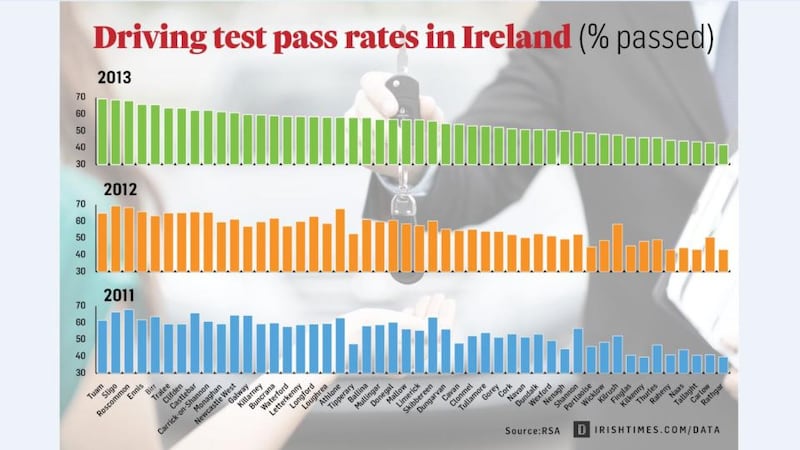Want to increase your chances of passing the driving test? Avoid the capital and head west. That’s if driving test pass rates over recent years are anything to go by.
Analysis by The Irish Times of outcomes for the State's 48 test centres show significant variations, with applicants up to two-thirds more likely to pass in a number of test centres west of the Shannon versus Dublin.
An average of driving-test pass rates between 2010 and 2013 shows Ennis topped the table (68.1 per cent pass rate), followed by Sligo (67.8 per cent), Tuam (64.5 per cent), Clifden (63.7 per cent) and Roscommon (63.3 per cent).

The greater Dublin area consistently recorded the lowest pass rates over the same period. Rathgar’s test applicants were least successful (41.3 per cent pass rate), followed by Raheny (41.9 per cent) and Tallaght (42.6 per cent) and Naas (44.1).
Test outcomes
These test outcomes compare with a national average of about 54 per cent between 2010 and 2013.
Younger drivers were more likely to pass the test, figures show, while male motorists had a higher success rate.
So, is the variation in rates simply down to the fact that driving testers get more generous the further west you go?
Or do test gets more challenging and technical in more built-up areas?
The Irish School of Motoring, which provides driving lessons in locations across the State, puts the variation down to the test courses.
“If you look at places like Ennis or Sligo they don’t have the same volume of traffic or technical issues like roundabouts or traffic lights,” according to Dave Fay, the school’s training manager.
“In some routes, the test lasts 45 minutes. But we’ve come across test routes where it can be just 15 minutes.”
While busier and built-up areas tend to have lower pass rates, this isn't always the case. Galway, for example, has consistently had a pass rate above 60 per cent over the past four years.
The Road Safety Authority – which is responsible for the driving test – insists its gives high priority to ensuring there are uniform standards at all centres, regardless of where the test is or who carries it out. Drivers can choose any centre in the country to sit their test.
It says there are a variety of factors – such as age and gender, along with the quality of tuition a candidate has received – which can lead to variations in test outcomes.
These variations, for example, also apply to outcomes for the theory test which vary by as much as 30 per cent.
Wicklow has the highest pass rate (79 per cent) while Kilkenny has the lowest (49 per cent).
“So, here’s a situation where it’s a human versus computer with few of the different aspects that will apply to any individual driving test like weather, road conditions, pedestrian activity or subjectivity, etc, and there are significant variations,” a RSA spokesman says.
However, the generosity of individual testers in the practical driving test has been identified as a factor before.
When the Comptroller and Auditor General investigated theses issues several years ago, it found average pass rates per tester ranged from between 23 per cent and 69 per cent.
The RSA says all instructors are trained to help ensure tests are carried out in the most consistent manner possible.
Ireland is not exceptional when it comes to variations in driving test pass rates.
Similar patterns
The UK-based Driving Standards Agency has also noted similar patterns in urban and rural areas, as have other countries such as Canada and Sweden.
So, how do Irish drivers compare to the rest of Europe when it comes to passing the test?
The latest research in 2004 showed our pass rates were around average. The lowest pass rates were in the UK (just over 40 per cent) and the highest in Austria and Slovakia (just over 90 per cent).
In reality, though, it’s hard to compare jurisdictions due to the different testing regimes.
Some countries require up to 40 hours of formal driving lesson, while many do not allow learner drivers on the open road even with a qualified driver.
Either way it’s fair to say that passing a test is getting harder than it used to be.
In 1979, about 60,000 drivers in Ireland were given an amnesty without having to even sit a test. There no such good hope for today’s would-be licence holders.
New candidates are required to take at least 12 hours of lessons before sitting the test.
And, if anything the tests may well be getting stricter – pass rates in Ireland have fallen from 57 per cent in 2008 to 52 per cent last year.











